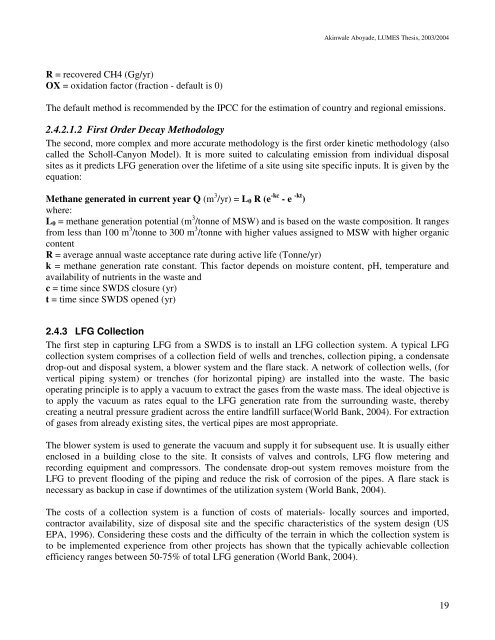Wale Aboyade's thesis - lumes
Wale Aboyade's thesis - lumes
Wale Aboyade's thesis - lumes
You also want an ePaper? Increase the reach of your titles
YUMPU automatically turns print PDFs into web optimized ePapers that Google loves.
Akinwale Aboyade, LUMES Thesis, 2003/2004<br />
R = recovered CH4 (Gg/yr)<br />
OX = oxidation factor (fraction - default is 0)<br />
The default method is recommended by the IPCC for the estimation of country and regional emissions.<br />
2.4.2.1.2 First Order Decay Methodology<br />
The second, more complex and more accurate methodology is the first order kinetic methodology (also<br />
called the Scholl-Canyon Model). It is more suited to calculating emission from individual disposal<br />
sites as it predicts LFG generation over the lifetime of a site using site specific inputs. It is given by the<br />
equation:<br />
Methane generated in current year Q (m 3 /yr) = L 0 R (e -kc - e -kt )<br />
where:<br />
L 0 = methane generation potential (m 3 /tonne of MSW) and is based on the waste composition. It ranges<br />
from less than 100 m 3 /tonne to 300 m 3 /tonne with higher values assigned to MSW with higher organic<br />
content<br />
R = average annual waste acceptance rate during active life (Tonne/yr)<br />
k = methane generation rate constant. This factor depends on moisture content, pH, temperature and<br />
availability of nutrients in the waste and<br />
c = time since SWDS closure (yr)<br />
t = time since SWDS opened (yr)<br />
2.4.3 LFG Collection<br />
The first step in capturing LFG from a SWDS is to install an LFG collection system. A typical LFG<br />
collection system comprises of a collection field of wells and trenches, collection piping, a condensate<br />
drop-out and disposal system, a blower system and the flare stack. A network of collection wells, (for<br />
vertical piping system) or trenches (for horizontal piping) are installed into the waste. The basic<br />
operating principle is to apply a vacuum to extract the gases from the waste mass. The ideal objective is<br />
to apply the vacuum as rates equal to the LFG generation rate from the surrounding waste, thereby<br />
creating a neutral pressure gradient across the entire landfill surface(World Bank, 2004). For extraction<br />
of gases from already existing sites, the vertical pipes are most appropriate.<br />
The blower system is used to generate the vacuum and supply it for subsequent use. It is usually either<br />
enclosed in a building close to the site. It consists of valves and controls, LFG flow metering and<br />
recording equipment and compressors. The condensate drop-out system removes moisture from the<br />
LFG to prevent flooding of the piping and reduce the risk of corrosion of the pipes. A flare stack is<br />
necessary as backup in case if downtimes of the utilization system (World Bank, 2004).<br />
The costs of a collection system is a function of costs of materials- locally sources and imported,<br />
contractor availability, size of disposal site and the specific characteristics of the system design (US<br />
EPA, 1996). Considering these costs and the difficulty of the terrain in which the collection system is<br />
to be implemented experience from other projects has shown that the typically achievable collection<br />
efficiency ranges between 50-75% of total LFG generation (World Bank, 2004).<br />
19

















